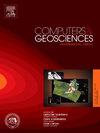MIST:通过化学计量学自动识别矿物的在线工具
IF 4.4
2区 地球科学
Q1 COMPUTER SCIENCE, INTERDISCIPLINARY APPLICATIONS
引用次数: 0
摘要
矿物的鉴定是使用和解释地球和行星材料的基础。矿物是由它们的化学和晶体结构来定义的。识别矿物的一种常用方法包括使用电子探针微分析仪(EPMA)等仪器来测量颗粒或晶体的化学成分,并将元素比例与已知矿物进行比较,即化学计量学,但这需要用户的专业知识,并且通常需要对预期矿物的一些先验知识。在这里,我们提出了MIST(矿物化学计量学鉴定),这是一种基于矿物化学计量学的模型,用于识别与天然矿物组成相匹配的元素比的地球化学观测。MIST使用标准化的氧化物重量百分比和元素之间的化学计量比,在基于经过验证的矿物配方和成分的详细分层规则分类方案中识别矿物相。该模型包括允许在天然矿物分析中常见的空缺和元素替换的公差。MIST专注于含氧的岩石形成矿物,并针对经过验证的矿物分析的标准数据集进行测试。当前版本的MIST 3.0可以识别246种矿物或化学计量学上无法区分的物种集,并有能力在未来的版本中扩展可识别的物种数量。MIST输出精确的矿物公式、相关的矿物末端成员和中间计算中使用的值。与其他矿物识别方法一样,化学计量矿物识别应该与其他数据集进行比较,包括氧化物总量、结构或结构信息。我们使用MIST在GEOROC数据库中过滤了超过100万种矿物化学分析,产生了超过87.5万种具有标准化标签、公式和矿物描述符的天然矿物分析,这些分析可用于机器学习模型。MIST提供了一种快速、准确、标准化的方法来识别高分辨率化学数据集中的矿物,同时最大限度地减少了所需的矿物学专业知识。本文章由计算机程序翻译,如有差异,请以英文原文为准。
MIST: An online tool automating mineral identification by stoichiometry
The identification of minerals is fundamental to the use and interpretation of earth and planetary materials. Minerals are defined by their chemistry and crystalline structure. A common way to identify minerals involves using instruments such as an Electron Probe Micro-Analyzer (EPMA) to measure the chemistry of a grain or crystal and compare element ratios to known minerals, i.e. stoichiometry, but this requires user expertise and often some prior knowledge of expected minerals. Here, we present MIST (Mineral Identification by SToichiometry), a mineral-stoichiometry-based model to identify geochemical observations with elemental ratios that match natural mineral compositions. MIST uses normalized oxide weight percentages and stoichiometric ratios between elements in a detailed hierarchical rules-based classification scheme based on validated mineral formulas and compositions to identify mineral phases. The model includes tolerances allowing the vacancies and elemental substitutions common in natural mineral analyses. MIST is focused on rock-forming mineral species containing oxygen and is tested against a standard dataset of validated mineral analyses. The current version of MIST, 3.0, can identify 246 mineral species or stoichiometrically indistinguishable sets of species, with the capability to expand the number of species recognized in future versions. MIST outputs precise mineral formulas, relevant mineral endmembers, and values used in intermediate calculations. As with other mineral identification methods, stoichiometric mineral identifications should be compared to other datasets, including oxide totals, textures, or structural information. We used MIST to filter over a million mineral chemistry analyses in the GEOROC database, resulting in over 875,000 natural mineral analyses with standardized labels, formulas, and mineral descriptors that can be used for machine learning models. MIST provides a rapid, accurate, standardized way to recognize minerals in high-resolution chemical datasets while minimizing required mineralogical expertise.
求助全文
通过发布文献求助,成功后即可免费获取论文全文。
去求助
来源期刊

Computers & Geosciences
地学-地球科学综合
CiteScore
9.30
自引率
6.80%
发文量
164
审稿时长
3.4 months
期刊介绍:
Computers & Geosciences publishes high impact, original research at the interface between Computer Sciences and Geosciences. Publications should apply modern computer science paradigms, whether computational or informatics-based, to address problems in the geosciences.
 求助内容:
求助内容: 应助结果提醒方式:
应助结果提醒方式:


